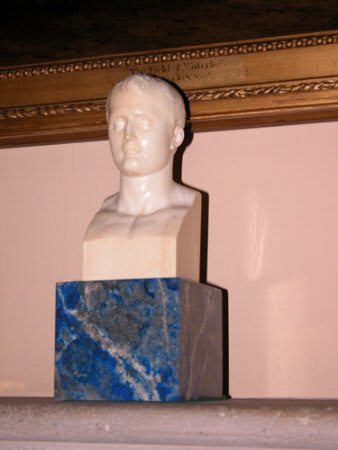Bust portrait of the Emperor Napoleon I (1769–1821)
after Antoine-Denis Chaudet (Paris 1763 - Paris 1810)
Category
Art / Sculpture
Date
circa 1800 - 1815
Materials
Ivory on lapis lazuli
Measurements
264 mm (Height)
Place of origin
France
Order this imageCollection
Anglesey Abbey, Cambridgeshire
NT 516583
Summary
Ivory, Bust portrait of the Emperor Napoleon I (1769-1821), after Antoine-Denis Chaudet (1763-1810), c. 1800-15. A carved ivory bust of Napoleon Bonaparte (1769-1821), Emperor Napoleon I of France, in the form of a herm, after a model by Antoine-Denis Chaudet (1763-1810). Mounted on a lapis lazuli base. Presented to the Thames Waterman Thomas Bain by the Emperor Napoleon III (1808-1873), in recognition of the gallantry shown by Bain in saving two lives at a regatta held on the Seine in 1867.
Full description
This small bust of Napoleon I, Emperor of the French (1769–1821), is a version of a well-known bust of the Emperor made by his favourite sculptor, Antoine-Denis Chaudet (1763-1810). An announcement appeared just one month after the proclamation of the Empire in June/July 1804 that life-size busts of the Emperor in plaster by Chaudet were available for purchase. The severe image in the form of a herm reflected the contemporary taste for the Neo-classical style, which was especially popular in France, and also helped to bolster the new Emperor’s pretensions through its propagandistic use to suggest parallels with ancient Roman virtue. Chaudet’s bust of the Emperor was diffused in innumerable examples in plaster, marble, bronze and biscuit porcelain (Gérard Hubert and Guy Ledoux-Lebard, Napoléon. Portraits contemporains: bustes et statues, Paris 1999, pp. 78-87). Chaudet obtained an exclusive privilege controlling the reproduction of his bust of the Emperor. Huge numbers were made in the marble workshops in Carrara from 1807 onwards. An example in marble is at Felbrigg (NT 1401964). The small ivory bust at Anglesey Abbey is close in size to a version made in biscuit porcelain at the Sèvres manufactory (29 cm. high), and it may be that it was copied from one of these small versions. Like many of the marble copies, the Sèvres biscuit versions bear the name ‘NAPOLEON’ on the front of the bust; however, this is missing from the ivory. Thames Watermen are the workers who for centuries have transported passengers along and across the River Thames in London. Watermen differ from Lightermen, who move goods to and from vessels. Practitioners of both trades were historically licensed by the Company of Watermen and Lightermen, a City Guild without Livery. Nothing is known of the incident during a regatta on the river Seine in Paris in 1867, in the course of which Thomas Bain rescued two people from drowning, and was presented by the Emperor Napoleon III with this well-carved bust of his uncle, the Emperor Napoleon I. Jeremy Warren 2019
Provenance
Purchased by Urban Huttleston Rogers Broughton, 1st Lord Fairhaven (1896-1966) from David Black on 13 June 1951, for £40, ‘Finely carved ivory Bust of Napoleon, c. 1810.’; bequeathed to the National Trust by Lord Fairhaven with the house and the rest of the contents.
Credit line
Anglesey Abbey, The Fairhaven Collection (The National Trust)
Marks and inscriptions
On brass plate affixed to back of bust: THIS BUST/ OF/ THE EMPEROR NAPOLEON I/ WAS PRESENTED TO/ THOMAS BAIN/ (THAMES WATERMAN)/ BY/ THE EMPEROR NAPOLEON III/ IN RECOGNITION OF/ THE GALLANTRY DISPLAYED BY HIM/ IN SAVING TWO LIVES/ AT/ A REGATTA HELD ON THE SEINE/ IN 1867
Makers and roles
after Antoine-Denis Chaudet (Paris 1763 - Paris 1810), sculptor
References
Christie, Manson & Woods 1971: The National Trust, Anglesey Abbey, Cambridge. Inventory: Furniture, Textiles, Porcelain, Bronzes, Sculpture and Garden Ornaments’, 1971, p. 80.

